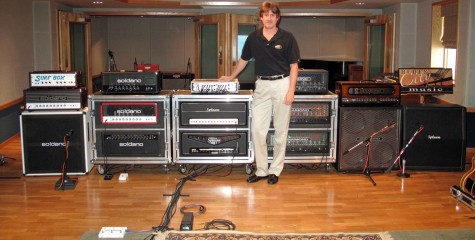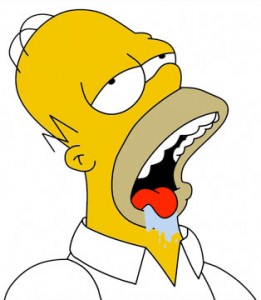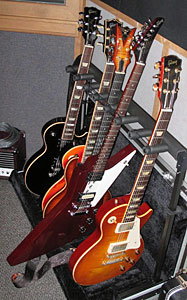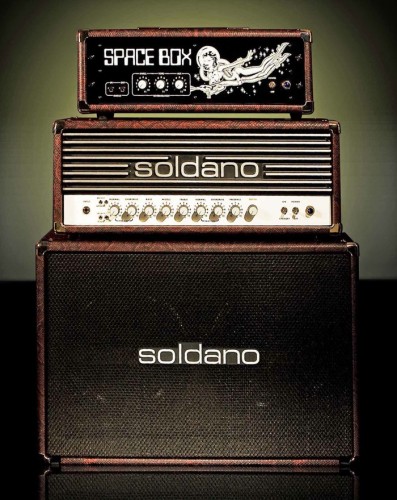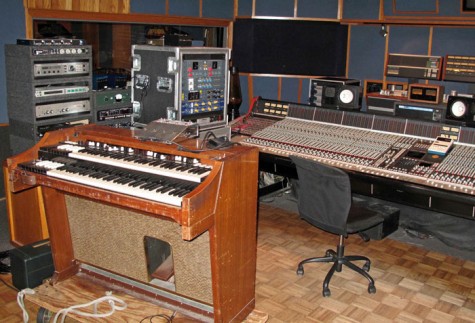Skynyrd Covered: Gear (Part 2)
[Part 1 of this post is here.]
Have to borrow a line from Homer Simpson: Ahhhhhhhhh, gear.
Anyhow, some tunes – like “The Needle and the Spoon” and “Simple Man” – sound like period-correct gear and tones, whereas tunes like “Saturday Night Special” sound a lot more modern. I wanted to know – we all want to know – what gear was used and how the guit-slingers chose it.
What’s interesting about these two guys – James “Lynn†Burke and Steve “Kish†Moody – is they appear to have totally different geard-headedness. Lynn is nuts about gear, and Kish is a plug ‘n play dude, which is why Kish is first below: Lynn’s answer is a lot longer!
Kish’s Gear
Kish talking:
For “The Needle and the Spoon” lead guitar tracks, I used a Gibson Explorer with a Splawn Quick Rod in second gear, and s Splawn 4×12 slant cabinet with a mix of Celestion Vintage 30s and Eminence Big Blocks. [Lynn said: “Big Blocks are essentially high-powered Celestion G12H30s with a rating of around 60-70w.”]
I used the Quick Rod due to the Marshall-like tone, but it has more precision and power than Marshall amps. I love Splawn Amps because they’re carefully hand-crafted by Scott Splawn.
On “Saturday Night Special” I used Mary Alice – my ’60 reissue Gibson Les Paul Classic – into the Splawn Quick Rod. I used third gear and cranked up the gain to give a heavier modern feel because “Saturday Night Special” had so much potential to have a that feel.
For the lead part I used a Splawn Nitro, and a stereo Ibanez Frying Pan [phaser] pedal and Dunlop Cry Baby Classic.
Of course good guitar tones are nothing without good engineering, which came from House of Melody Studio and engineer Stephen Shatzer of Gravel Ridge, AR, as well as Pete Matthews of Ardent Studios in Memphis.
Lynn’s Gear
Lynn talking:
Besides playing guitar on this record as a band member of House of Melody, I also own Blues City Music, in Memphis, TN. My specialty is extremely high end, USA handmade boutique guitars, amps and effects, so there was definitely a lot of choices for gear.
What we did do that may be different than most Lynyrd Skynyrd recreations was to record at extreme volumes to simulate the “live” sound. This was not going to be a sleepy album – we wanted the guitars to be huge.
Foundation
My first choice as our foundation was a guitar/amp/cabinet combination that would make sure the guitar rhythms were dead-to-rights era correct. I don’t mean close, but exact.
The first choice for me was my own 1969 Marshall Super Lead Tremolo 100w amp with EL34s. It’s a 4-input non-master-volume amp with all original Mustard caps and resistors as well as the original Drake and laydown transformers. It also incorporates the plexi circuit being made before 1970, but has a metal front instead of the plexiglas.
I bridged the top right input to the bottom left input, then plugged the guitar into the top left input. This made sure the Normal channel wasn’t too dark, and the Bright channel wasn’t to shrill.
My guitar choice was a 2005 Gibson Les Paul Standard (’50s neck profile), but the only thing original on it is the logo and ebony paint. It has:
> Jason Lollar-chosen hand-wound “low wind Imperial PAF” pickups at 7.6 ohms bridge and 6.7 ohms neck;
> CTS pots with treble-bleed circuits on both volume pots and “1959” pickup wiring;
> A Tone Pros complete bridge assembly with the tailpiece screwed all the way down;
> Stainless steel jumbo frets, a Plek’d fretboard and the Buzz Feiten tuning system using the shelf nut;
> Schaller tuners;
> DR Tite Fit .010-.050 strings.
Joe Glaser in Nashville finished this guitar for me and it plays and sounds fantastic.
Cabinet choice was a custom-made Scott Splawn era-correct, closed-back 2×12 cabinet with Jim Seavall chosen H55 16HP Scumback speakers for an 8 ohm load. These speakers are based on the pre-Rola speakers and are made of the same paper that original Celestion Greenback speakers are made from.
Doubling
I doubled the rhythm tracks using my 2006 Tom Anderson Cobra S guitar with Tom Anderson H1 and H3 humbucker pickups, fretboard-spaced Buzz Feiten tuning system, Sperzel locking tuners the same strings. I didn’t use the tremolo at all – just took the whammy bar off. The H3 is pretty hot by most standards, but even at 11.1 ohms it was clear as a bell.
I then used either my own one-off Soldano SLO-100 head with 6L6s, my Diamond Amplification one-off Spitfire II head with winged C EL34s, or Kish’s Splawn Quick Rod with Mullard EL34s.
The SLO is a 5-option head that has the Warren Haynes bright-cut switch on the overdrive channel, mid scoop up to about 420 hertz on the Normal channel, the Depth option on both channels, a 1/2 power switch, and an effects loop bypass switch. It’s housed in a black and burgundy snakeskin tolex head shell with one of the last “Avenger” amp cast aluminum Soldano logo grilles.
I ran in 50w mode with only the loop bypassed, and didn’t use any of the other options. I ran the Diamond with the loop engaged, and the Splawn with the loop bypassed, but both amps were in 100w modes.
Effects
We never used any Pro Tools or outboard digital effects at all with this record. We just didn’t think digital had a home here, and made sure that when we did use effects, they were all analog.
I only used a Maxon AD999 analog delay with just a hint of delay for my leads, and a Klon Centaur Overdrive without any gain set – nothing else. It was all plug and play right into the guitar input most of the time.
Tracking
We wanted huge rhythm tracks for “Saturday Night Special,” and you’ll see how we changed the timing a bit with the prelude to each chorus. That was Kish’s idea and it really works live for us.
I ran the Marshall with the SLO-100 for my parts, but what was so cool about the prelude to the long solo was that Kish had this idea of running his Splawn Quick Rod in stereo with his Splawn Nitro to simulate the organ.
We hooked them up to an Ibanez Frying Pan stereo pedal and Kish played this one slide part that sounded like a killer organ and Leslie speaker cabinet when it swirled back and forth from each of the amps. I like it better than the original organ, quite frankly.
For the long solo, I actually tried to track that myself, but we all agreed after trying that the solo Gary Rossington laid down for the original song had so much soul and feel to it that there just wasn’t any way to recapture that on a recording and do it justice even though I knew it note for note. Some things are better left alone, and for that one, we chose to let Kish add his own version.
“Simple Man” was more true to form, but you’ll see where we add a harder edge to the pre-chorus as well as the chorus itself. Being that we made changes here, I decided to do the solo dead to rights with the SLO-100 and Tom Anderson Cobra S. We think that worked best for us.
“Tuesday’s Gone” became a compilation of a multitude of different versions Skynyrd has done through the years. I used three different versions and combined them into one long version for the final solo of the song.
I wanted it loud and proud so I went with the Tom Anderson and SLO-100 – all overdrive channel and guitar volumes wide open. My daughter and her best friend sang backup vocals, which was pretty cool. They’re both professional singers and tracked it at their school, Belmont University in Nashville, with Ian Zorbaugh running the 48-channel Neve console.
Finally, “The Needle and the Spoon” for us became our signature song for the record. Kish was just on another planet and nailed all of his parts. Plus all the lead vocals are his, and that voice of his just reeks true Southern Rock as good as anyone.
Kish played all the leads here and fills as well. I covered all the rhythm tracks. If you listen closely, you’ll hear a National dobro on the second and third verses. Kish brought one to just mess around with while our friend/producer, Pete Matthews of “Evanesence” fame, tracked me.
Pete heard Kish and said, “Dude, that is going on this track, get it dead in tune and let’s track it.” The vibe was rolling, so we did just that and of course Kish once again covered all of that part in one take.
For the harmony parts I used my Tom Anderson again with the SLO-100. Not too much gain on this track, but the SLO was still roaring for sure.
Engineering
Finishing up the record was pretty cool as well. Our good friend Brad Blackwood of Euphonic Masters had just won the very first Grammy Award ever given to a mastering engineer in LA at the 2012 Grammys. He won it for Allison Krauss’s “Paper Airplane” record.
When he came back home to Memphis, the first track he mastered after winning this award was our version of “The Needle and the Spoon!”
Yeah, that song became really special to us as has the entire record. We did it the best we could, and we did it the way we do things in the Ridge. Gravel Ridge, that is.
More from Lynn
Miscellany from the interview:
> For the last three songs on the record, we tracked with Steven Shatzer running the Pro Tools console at his and Kish’s studio in Gravel Ridge, AR. Nick Carter played drums for us while singing backup vocals on “Tuesday’s Gone,” and Kish played all bass lines, multiple lead solos, sang all lead vocals, and played my Collings D2H Dreadnaught acoustic guitar with LR Baggs M1 passive soundhole pickup as well.
> On “The Needle and the Spoon,” we brought in some good buddies to help us out since we were recording at world famous Ardent Studios in Memphis. Rick Steff, keyboardist with “Lucero,” Landon Moore, bassist with “Haven Hill,” and Rickey Shelton, drummer and formerly of “Dust for Life,” tracked some amazing parts for us. After they heard what Kish and I had in store for this song and project they definitely wanted in.
Category: Celestion speakers, Diamond amps, Dunlop/Cry Baby, Eminence speakers, Explorer, Gibson, House of Melody band, Ibanez effects, Klon, Les Paul, Lollar, Lynyrd Skynyrd, Maxon, PRS, Soldano, Splawn, Tom Anderson, Tone Pros

